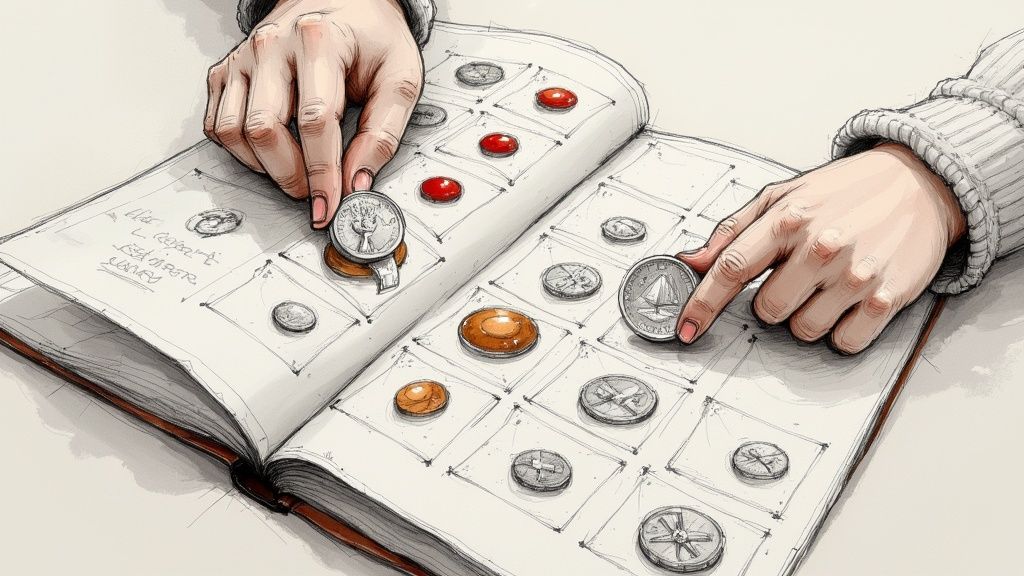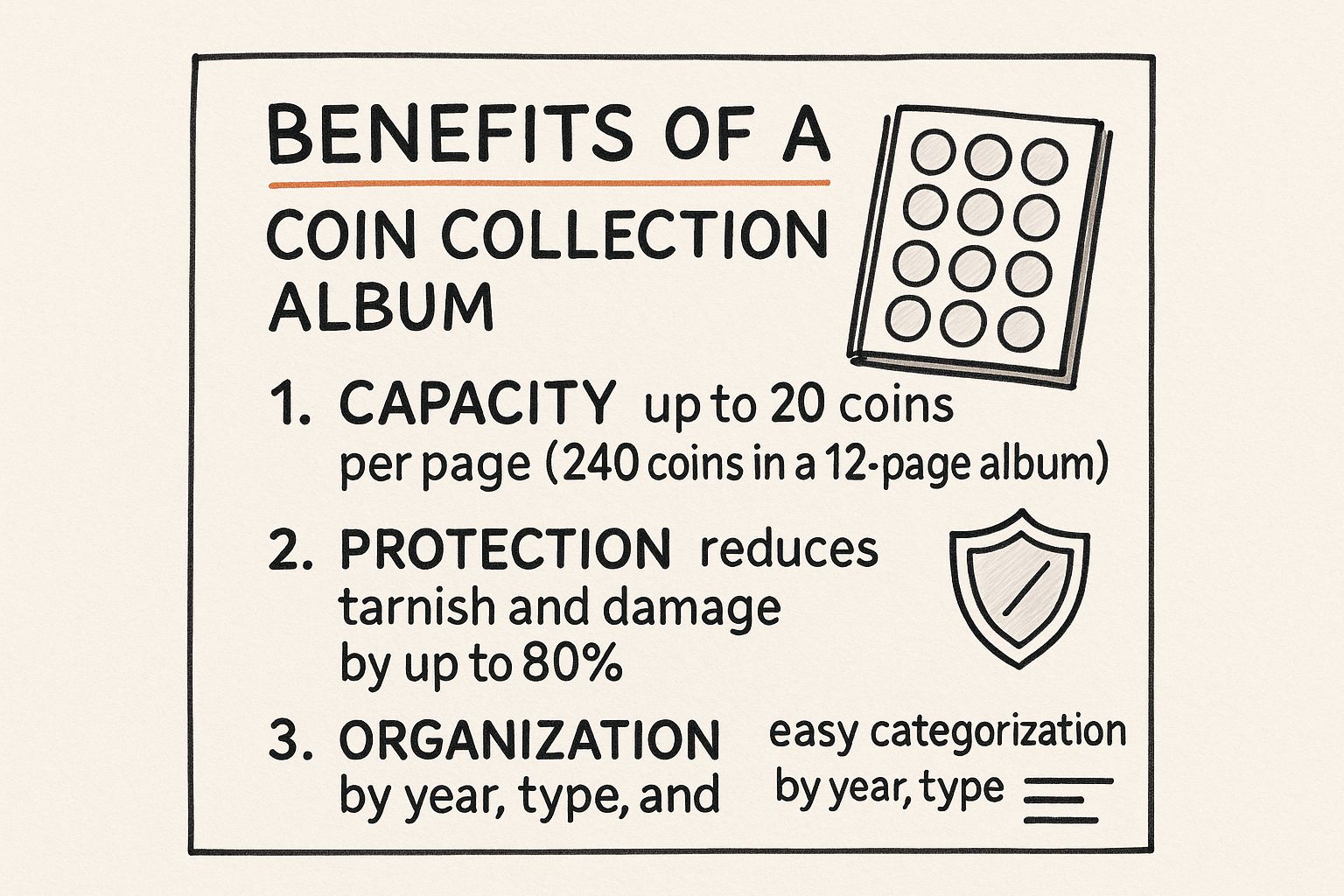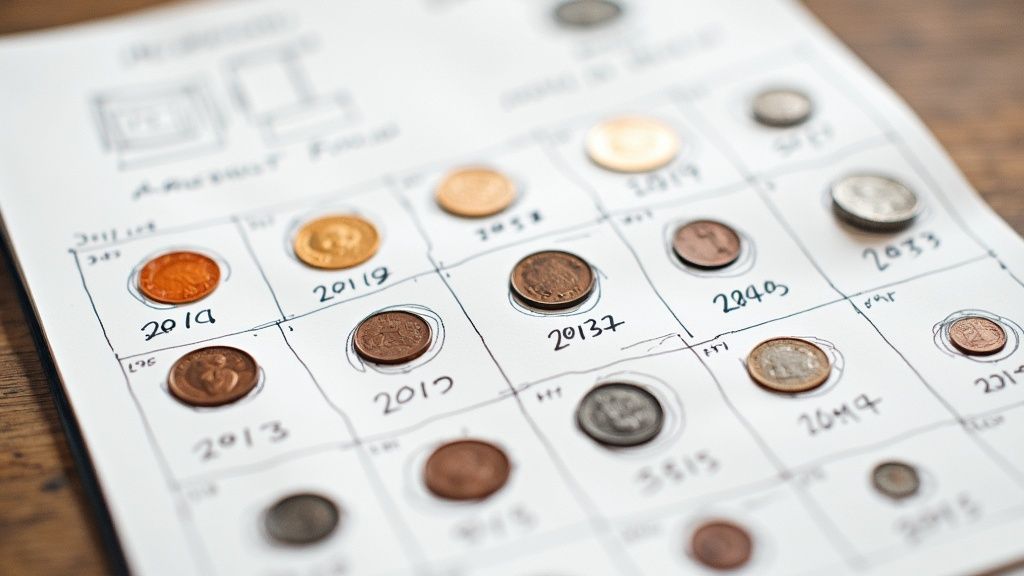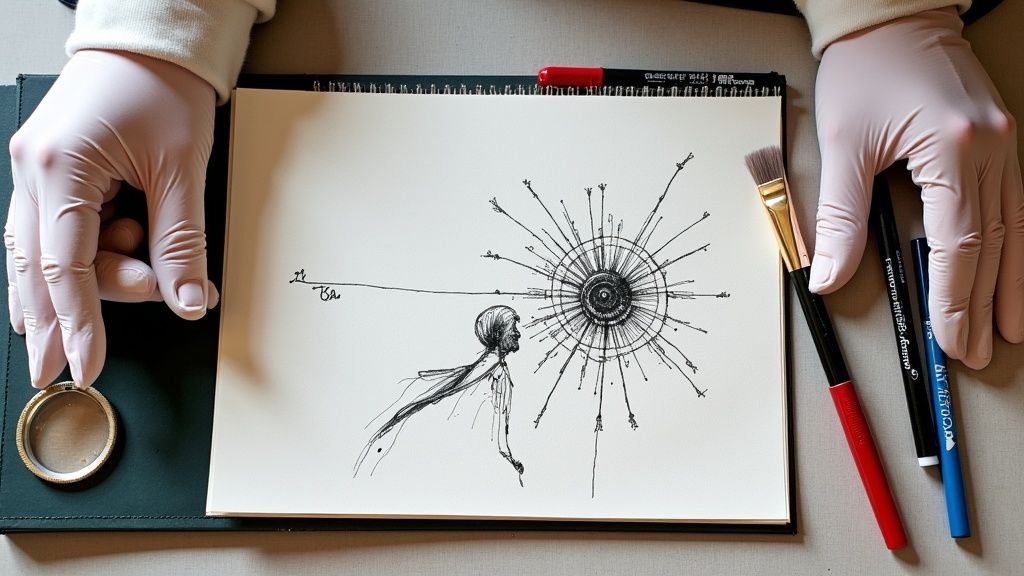A high-quality coin collection album is much more than just a place to keep your coins; it's probably the single most important tool you'll own for preserving their value and story. It’s what stands between your collection and the elements, organising everything into a curated display you can be proud of for years to come. Finding the right one is really the cornerstone of any serious collection.
Why Your Coins Need the Right Home

The moment you get your hands on a truly special coin, like a rare Kew Gardens 50p, you realise a simple jar or tin just won't do. Your collection is more than just loose change; it’s an investment of your time, your passion, and often, a good bit of money. These treasures need a proper home.
Improper storage is the quickest way to see a coin's value plummet. Everyday materials that seem harmless can actually pose a serious threat.
- PVC Damage: Lots of cheap, flexible plastic holders are made with Polyvinyl Chloride (PVC). Over time, this chemical leeches out and creates a sticky, green gunk that can permanently eat into a coin's surface.
- Acidic Paper: That standard paper and cardboard you might use for inserts contains acids that will cause toning and corrosion, messing with the coin's original lustre and appearance.
- Physical Scratches: Tossing coins into tins or boxes means they’re constantly rubbing up against each other. This inevitably leads to scratches and nicks that are impossible to fix.
A proper coin collection album is specifically designed to stop these things from happening. Think of it as a miniature vault for each individual piece, shielding it from harm and preserving its condition. This isn't just about storage; it's about active preservation.
When you choose an archival-quality album, it elevates your entire hobby. It takes what might be a scattered assortment of coins and turns it into a structured, impressive display. You can start organising your pieces by monarch, denomination, or theme, and suddenly, you're telling a visual story of British history.
This isn't just about protecting a bit of metal; it’s about honouring the effort you've poured into building your collection. By giving your coins a safe and organised environment, a good album ensures they can be enjoyed by you—and maybe even future generations—without losing their historical or monetary worth.
Matching an Album to Your Collecting Style
Finding the perfect coin collection album isn't a one-size-fits-all job. The right choice really depends on the story your collection tells—your specific goals, the coins you love, and how you want to show them off.
Think about it. If you're painstakingly trying to complete a popular set, like The Great British Coin Hunt for 50p or 10p pieces, you'll want a folder with pre-labelled slots. These albums give you a clear roadmap, showing you exactly which coins you have and which gaps you still need to fill. There’s a real sense of achievement every time you pop a new coin into an empty slot.
Finding the Right Fit for Your Coins
But what if your collection is a bit more… eclectic? Maybe you’ve got a mix of modern British commemoratives, some old pre-decimal currency, and a few interesting foreign coins you picked up on holiday. In that case, a rigid, pre-set album is just going to hold you back.
A versatile ring binder system with different page inserts is the way to go here. It gives you the freedom to mix and match pages with various pocket sizes. You can easily house a chunky Victorian Crown right next to a slim modern ten pence piece, all in the same album. This approach lets your album grow and adapt as your interests do. For a closer look at specific models, you can check out our guide on the top coin collecting albums for 2025.
A good album does more than just hold your coins; it protects and organises them.

As you can see, the right album provides significant capacity, drastically reduces the risk of damage, and keeps your treasured collection perfectly organised.
Coin Album Types at a Glance
Choosing an album style can feel overwhelming at first. This table breaks down the most common types to help you find the best fit for your collection.
| Album Type | Best For | Pros | Cons |
|---|---|---|---|
| Pre-Printed Folders | Completing specific sets (e.g., 50p hunts, commemorative series). | Clearly labelled slots, satisfying to fill, affordable. | Inflexible, not suitable for varied or growing collections. |
| Ring Binders | Eclectic or expanding collections with varied coin sizes. | Highly customisable, can add/rearrange pages, good protection. | Can be bulkier, initial setup might be more expensive. |
| Slab Albums | Professionally graded and encapsulated ("slabbed") coins. | Maximum protection for high-value items, secure fit for bulky holders. | Specific use case, not for raw (ungraded) coins. |
| Wooden Trays | Displaying a few select, high-value individual coins. | Elegant, museum-quality presentation, excellent for display. | Limited capacity, offers less protection from air and moisture. |
Ultimately, your choice comes down to balancing how you want to view your collection with how you need to protect it.
Specialised Albums for Unique Collections
Beyond the usual suspects, there are more specialised options out there. If you invest in professionally graded coins sealed in plastic holders (often called "slabs"), a dedicated slab album is a must. These are built with deep, sturdy slots designed to securely grip these bulky cases, making sure your most valuable items are properly protected.
UK collecting has always had a soft spot for error coins and limited-run specials, and these often end up in their own dedicated albums because they're so scarce. The classic example is the 2009 Kew Gardens 50p, with only 210,000 ever minted. Its rarity single-handedly drove a huge market for albums designed just for 50p coins and other commemorative series.
Decoding Archival Quality Materials

When you start looking at coin albums, you’ll quickly see that they aren't all made the same. The phrase "archival quality" isn't just a fancy marketing term—it's your guarantee of genuine, long-term preservation for your collection. The materials your coin collection album is made from are quite literally the only thing standing between your coins and irreversible damage.
The single greatest enemy you need to watch out for is Polyvinyl Chloride (PVC). It’s a soft, bendy plastic often found in cheap photo albums and low-grade coin pages. The real trouble starts as it ages; PVC breaks down and leaches out oily plasticisers, which create a sticky, greenish film. This residue can permanently etch the surface of your coins, completely wiping out their numismatic value.
For this reason, you have to insist on materials that are completely PVC-free. It's simply not negotiable if you're serious about your collection. Look for pages made from inert, stable plastics like Mylar (polyester) or polypropylene. These are chemically stable and won't react with the metals in your coins, even after decades of storage.
Beyond the Plastic Pockets
The clear pockets are just one part of the equation. The paper inserts and even the binder itself play a massive role in keeping your coins safe and sound.
- Acid-Free Inserts: Any paper or card you use for labels or backing must be certified acid-free. Standard paper contains acids that will slowly cause ugly toning and even corrosion, staining your coins and destroying their original lustre.
- Binder Ring Design: Don't overlook the binder's construction. A D-ring binder is always a better choice than a standard O-ring. Why? Because D-rings allow the pages to lie perfectly flat when the album is closed. This simple design feature prevents the coins from being pushed, stressed, or popping out of their pockets.
Choosing archival-grade materials is a direct investment in your collection's future. It’s the difference between an album that merely holds your coins and one that actively preserves them for generations to enjoy.
As the UK coin collecting market has grown more sophisticated, we've seen a clear shift in what collectors demand. There’s a much bigger focus on proper preservation, which has driven the demand for albums with acid-free components and secure, inert pockets. They’ve gone from being simple holders to essential tools for any serious collector. You can find out more about these industry shifts and what they mean for collectors. Read the full research about the UK coin market growth.
Organising Your Collection Like a Pro
Now that you have the perfect archival-quality album in hand, the real fun can begin: turning that pile of coins into a properly curated collection. But before you slot a single coin into its new home, there's one golden rule you must follow to protect your treasures.
Always, and I mean always, handle your coins with soft, lint-free cotton gloves. Even if you've just washed your hands, the natural oils and acids on your skin can cause irreversible damage over time. Think unsightly fingerprints and even corrosion. When you do pick up a coin, hold it by its edges—never touch the flat faces (the obverse or reverse).
Choosing Your Organisational Method
How you decide to arrange your coins is a deeply personal choice. There’s no single right way to do it; the best method is the one that tells the story you want your collection to tell.
- By Monarch: This is a classic, especially for British coins. Arranging them chronologically by the reigning king or queen creates a fantastic visual timeline. You can literally watch the design of the nation's coinage evolve from Queen Victoria right through to King Charles III.
- By Denomination or Type: Maybe you want to dedicate a section of your coin collection album to a specific denomination. You could have a page just for shillings, another for florins, or perhaps focus on a wildly popular modern series like the commemorative 50p pieces.
- By Theme: Thematic collecting is a brilliant way to build a unique and focused collection. You could group coins related to the Olympic Games, royal weddings, or even a specific series like the much-loved "round pounds".
Whichever route you take, the key is consistency. A well-organised album is not just about looking neat; it makes the story and scope of your collection immediately clear, turning it from a simple set of coins into something truly impressive.
Creating a Simple Inventory
With your coins all safely housed, there’s one final step: creating an inventory. This doesn't need to be some complex database. A simple spreadsheet or even a dedicated notebook is perfectly fine.
For each coin, jot down the key details: its year, denomination, general condition, and any mintage figures you know. This simple record is invaluable for insurance purposes, tracking your collection’s value, and just seeing how far you’ve come. For a more detailed approach, you might find our guide on how to properly catalogue your coins really helpful.
This whole process feels particularly relevant right now, as our albums capture a major turning point in British history. Coins like the 2022 £1, bearing the final portrait of Queen Elizabeth II, truly mark the end of an era. As the new King Charles III coins enter circulation, our albums become tangible records of this historic royal transition.
Long-Term Album Care and Preservation

So, you've got your coins secured in the perfect album. That's a huge step, but the job isn't quite finished. Real long-term preservation is all about creating the right environment for your collection to thrive, and the single most important factor here is stability.
Your coin collection album needs to live in a cool, dry place where the humidity stays consistent. You want to avoid any extreme temperature swings—think of the conditions in a loft or a damp basement. Those changes can trigger oxidation and cause irreversible damage, something that copper and silver coins are particularly vulnerable to.
A bookshelf in a main living area, well away from direct sunlight or radiators, is usually an ideal spot.
Handling and Inspection
How you handle the album itself is just as critical as where you decide to keep it. When you're showing off your collection, always turn the pages gently from the outer edge. It's a small thing, but putting pressure directly on the coin pockets can stress the seals over time and lead to them failing.
Getting into the habit of regular, gentle checks is also a smart move.
- Quarterly review: Take a few minutes every few months to just flip through the album.
- Look for changes: Keep an eye out for any early signs of discolouration on the coins themselves or any cloudiness developing on the plastic pockets.
- Check for integrity: Make sure all the pockets and pages feel secure and are still fully intact.
Proper storage and careful handling aren't just about preventing damage; they are active measures that ensure your collection maintains its condition and value for a lifetime. These simple routines are your best defence against deterioration.
For a deeper dive into creating the perfect environment, exploring advanced coin collecting storage solutions can provide even more detailed strategies. Believe me, catching any potential issue early is the key to protecting your investment.
Your Top Coin Album Questions Answered
Even the most seasoned collectors run into questions about the best way to use a coin collection album. Getting the right answers is crucial for protecting your collection and sidestepping those common mistakes that can ruin your most prized coins.
One question that pops up all the time is about the safety of those older, vintage albums. While albums from the 1960s and 70s can look brilliant, many of them contain PVC. This plastic is bad news for coins, as it can break down over time and release acids, leaving a sticky green residue that causes permanent damage. If you have any valuable coins in one of these, it's always best to move them into a modern, archival-quality album made from safe materials like Mylar.
Best Practices for Your Album
What’s the best way to label coins in a customisable album? The number one rule here is to use acid-free paper for your inserts. You can jot down details with an archival-quality ink pen or even print off tidy labels for a cleaner look. Just make sure you include the important details:
- The Basics: Always list the coin's year, its denomination, and the country it came from.
- The Specifics: Don’t forget to note any special varieties or mint marks that make the coin stand out.
- For Valuable Coins: With your higher-value pieces, it's a good idea to add the grade and what you paid for it. This creates a solid record for insurance purposes or if you decide to sell later on.
Perhaps the most critical question is this: should you clean coins before putting them in an album? For 99% of collectors, the answer is a simple, straightforward no. Cleaning creates micro-scratches and strips away the natural patina, which can absolutely tank a coin's numismatic value.
The only real exception is if you need to remove that harmful PVC gunk we mentioned earlier—and that’s a delicate job best left to a professional conservator. In almost every other case, leaving your coin in its natural state is the best way to preserve its history and its worth. A good coin collection album is there to protect your coin exactly as it is, not how you think it ought to look.
At Cavalier Coins Ltd, we stock a wide range of archival-quality albums and accessories designed to help you protect and showcase your collection properly. Explore our collection and find the perfect home for your coins today.

